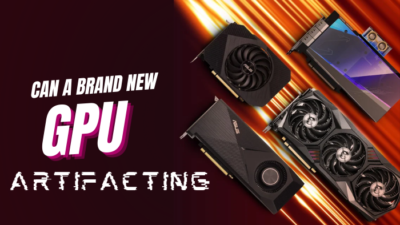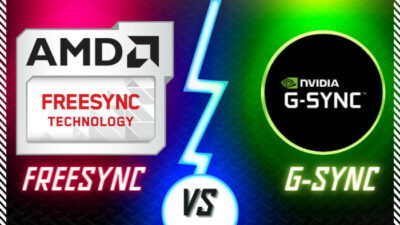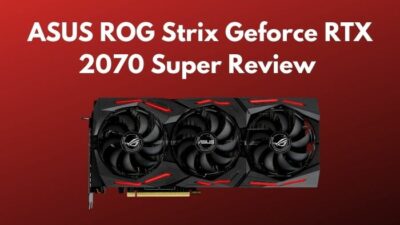Anyone familiar with multi-GPU rendering has heard the term SLI. As the mainstream monitor resolution has grown, the decades-old SLI technology hasn’t been able to keep up.
Hence, to turn the scalability up to 11, Nvidia has been pushing a newer multi-GPU scaling technology called NVLink.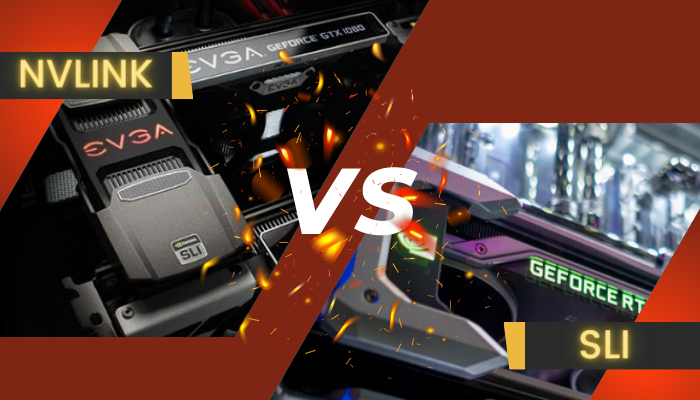
So what exactly is the NVLink & how is it any different than SLI? Let’s find out.
What is SLI?
SLI(Scalable Link Interface) is Nvidia’s multi-GPU rendering solution that boosts rendering performance by splitting the workload across multiple GPUs. AMD also has an equivalent solution named AMD Crossfire which works in a similar fashion.
This technology was first introduced to the public in 1998 by a company named 3dfx. It was later bought by Nvidia & rebranded as SLI. Nvidia officially released SLI technology in 2004 with a promise of vastly reducing rendering time by using up to four GeForce cards simultaneously.
So basically, SLI is Nvidia’s way of connecting two to four GPUs together which, in theory, increases computational performance without having to build a new PC for each GPU or waiting for the next-gen hardware.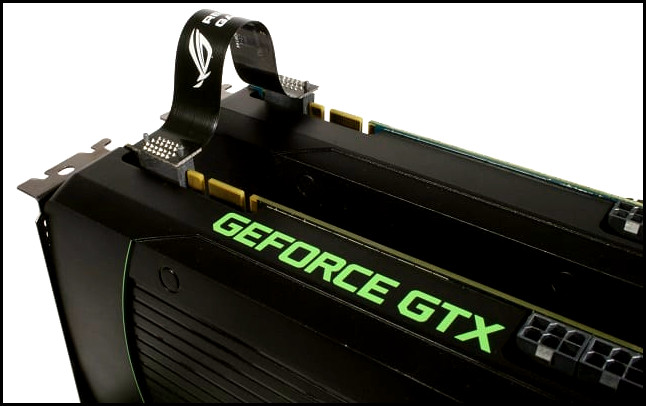
To utilize this feature, you’ll need an SLI-certified motherboard & two or more GeForce GPUs of the same model. Additionally, those GPUs need to be connected via an external SLI bridge.
This scaling technology uses 5 rendering modes to proportionally divide rendering workloads among available graphics cards. Here are those 5 SLI rendering modes:
- Alternate Frame Rendering (AFR)
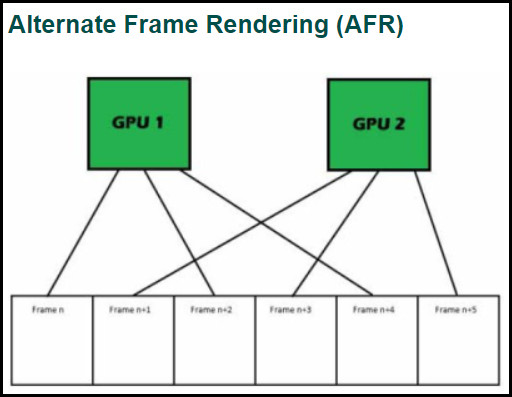
- Split Frame Rendering (SFR)
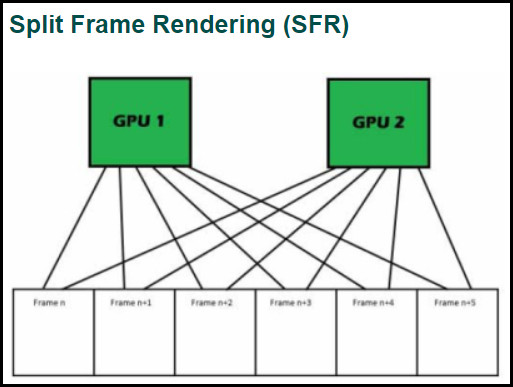
- Boost Performance Hybrid SLI
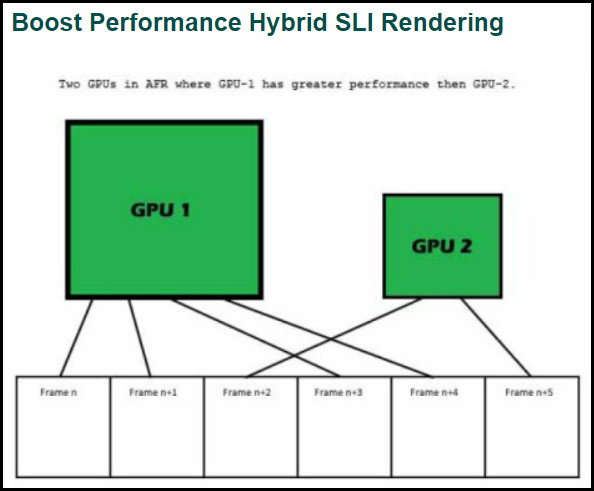
- SLIAA
- Compatibility mode
Furthermore, SLI works in a hierarchy relationship where one card functions as master, and the other(s) as slave(s). The master card divides, governs & directs the workload to the slave card(s) using the SLI bridge connectors at 2 Gbps bandwidth.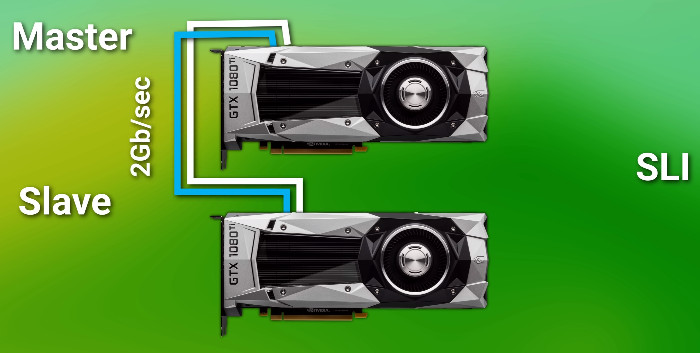
What is NVLink?
NVLink is a newer form of SLI technology with an improved connection protocol between multiple Nvidia GPUs aiming for a major uplift in bandwidth. It is also bi-directional and works as a mesh. So there’s no GPU hierarchy in this technique.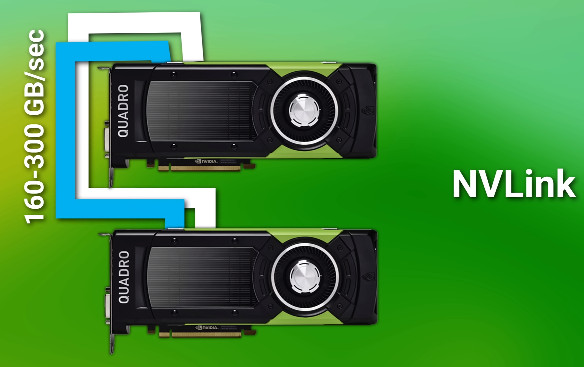
It uses a wired-based communication protocol for a significantly advanced and faster GPU interconnection.
For consumer-grade products, you can only connect 2 GPUs via NVLink. But for workstation/pro-grade products, you can link up to 256 GPUs at a staggering 57.6 terabytes per second speed using the NVSwitch.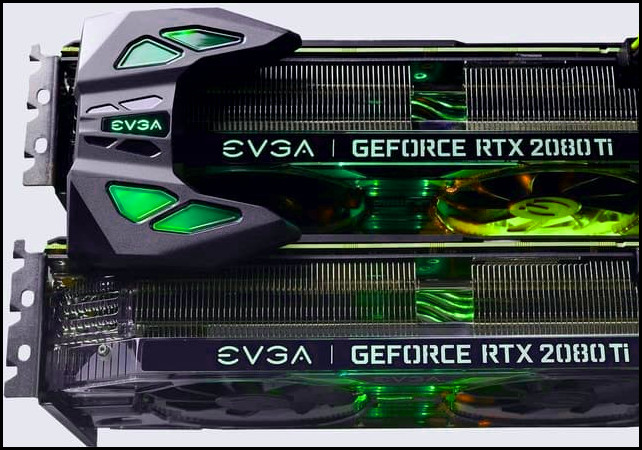
The purpose of such an insanely fast and beefy NVLink setup is to get an unprecedented performance in workstation related tasks. These tasks are so hardware demanding that the older SLI configuration fails to meet the demand, hence the need for NVLink setup.
NVLink vs SLI: Which One is Better for Multi-GPU Rendering?
While the SLI bridge can only achieve 2 Gbps bandwidth, the NVLink’s transfer speed can reach up to 300 Gbps. This resolves the bandwidth bottleneck of SLI, allowing the system to pool resources. Another noteworthy difference between NVLink & SLI is that there’s no master-slave hierarchy in NVLink.
As a result, users can finally get the combined VRAM pool of all the GPUs. Not only that, NVLink can transfer data from 160 to 300Gbps, which is far higher than what SLI bridges can do.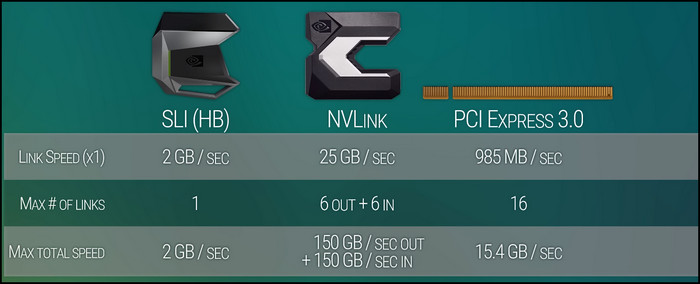
Since the master card alone registers and governs the workload, only the master GPU’s VRAM can be accessed by the system. As a result, if you’re using two 11GB cards, you won’t get a 22GB VRAM configuration. You’ll only have the master GPU’s 11GB VRAM available for usage.
Not only that, the physical interface of NVLink is vastly different than the SLI’s. The first thing you’ll notice in a card that’s equipped with NVLink is how big the connector fingers are compared to traditional SLI.![nvlink-vs-sli-connectors]](https://10scopes.com/wp-content/uploads/2023/03/nvlink-vs-sli-connectors.jpg)
As we can see, the NVLink connector is three times wider with way more pins than the SLI connector. Infact, NVLink’s connector looks almost like a little PCI Express connector. This actually has an underlying purpose, to create a mesh network among GPUs.
Speaking of connectors, another major difference between NVLink and SLI is the connector bridge & its pricing. NVLink bridge can cost up to 600$ compared to a high-end SLI bridge priced at 40 bucks.
Now that we’ve established the technical differences between the two GPU scaling technologies, which one is actually better? Well, obviously the newer, more advanced one.
Unlike an SLI setup, the mesh network of NVLink allows access to each card’s memory and CUDA cores as if they’re a single card. Hence, the performance boost of NVLink is significantly higher than traditional SLI which is perfect for high-end workstations.
NVLink vs SLI Productivity Performance
Let’s run a quick render test to see how well NVLink performs compared to SLI. For this, we’re gonna use two GTX 1080Ti for SLI config and two Quadro GV100 in NVLink setup.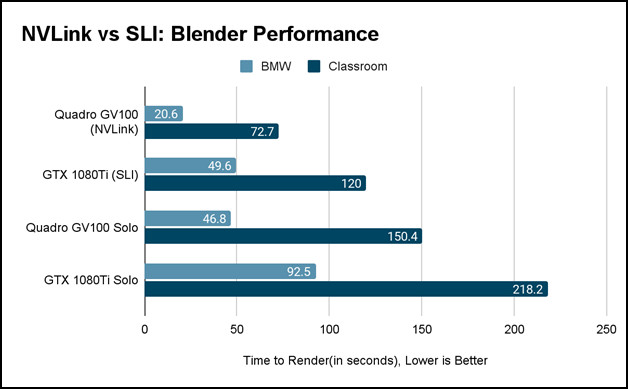
Unfortunately, many of my productivity software failed to cooperate with this multi-GPU setup(which I’ll discuss later on). But the ones that worked, managed to perform exceptionally well.
Blender’s BMW render took only 20 seconds to complete, which is noticeably faster than SLI’s almost 50 seconds render time.
Additionally, GTX 1080Ti’s SLI setup failed to perform better than a single GV100 card. But the NVLink managed to offer a significantly lower render time compared to all.
Now let’s change our focus from productivity to gaming performance.
NVLink vs SLI Gaming Performance
Again, since not many games support multi-GPU configuration, my choices were very limited. Still, I noticed a substantial performance gain while using NVLink over SLI. Here are the results:
Far Cry 5
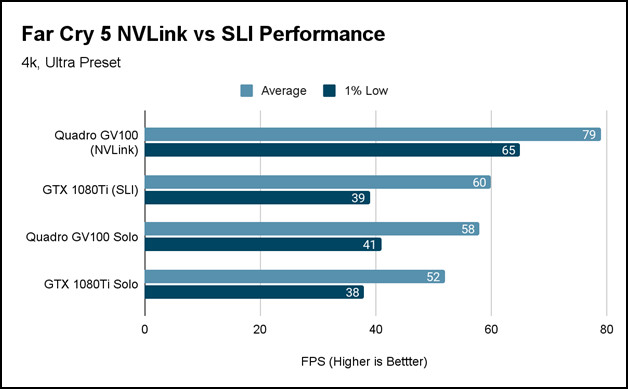
Deus Ex: Mankind Divided
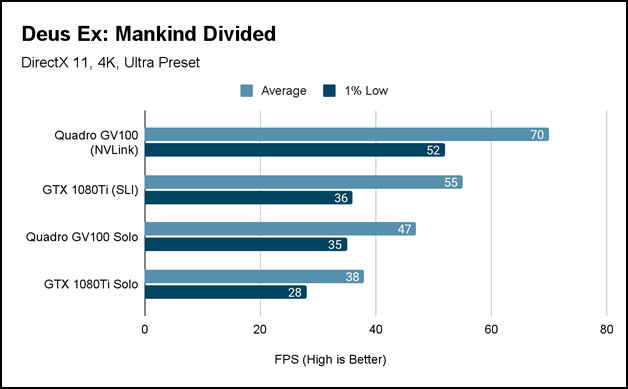
To no surprise, the GV100s’ NVLink configuration is the fastest on the block, gaining over 30-35% performance over 1080Tis’ SLI setup. Not only that, but the minimum framerate(1% low) also saw a nice boost in NVLink, offering a much smoother, stutter-free experience.
So gamers across the world should double their GPU purchase to get these noticeable benefits of NVLink, right? Nope, which brings us to our next topic…
The Demise of NVLink & SLI
The main reason why we can’t openly suggest general consumers go for NVLink or SLI is due to the lack of multi-GPU support. Barely any new game or software has support for SLI or NVLink.
Not only that, the performance gain from using two or more GPUs doesn’t justify the extra cost of buying another GPU(s).
Adding two graphics cards to your PC won’t give you 2x more performance than a single one, which we saw in our previous topic. So spending 100% more money for only 30-35% more performance doesn’t make any sense from a financial standpoint.
Furthermore, most games straight-up drop performance when I ran them in an NVLink or SLI setup. Here’s an example: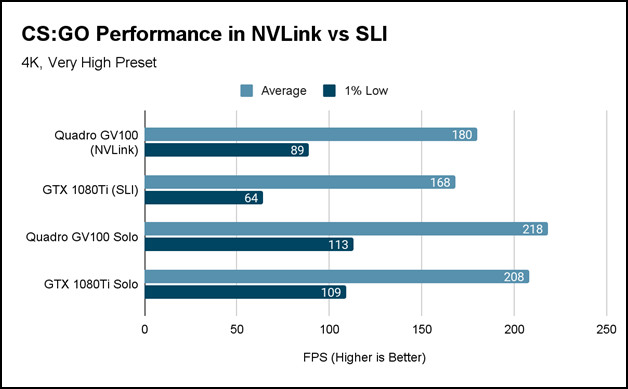
The average framerate literally dropped by a huge margin, almost to a point where I was able to notice a significantly choppier experience than running the game on a single GPU. The primary reason for such horrible performance is the lack of(or the difficulty of) optimization for real-time multi-GPU rendering.
Such a lack of optimization can introduce GPU artifacting issues for various workloads.
As I have mentioned before, many productivity software didn’t run properly when I tried to load them on my NVLink or SLI rig. Not to mention, general consumers aren’t willing to spend over 3000$ alone for the GPU segment.
Adding additional graphics cards prevents the graphics cards from getting the necessary GPU clearance for optimal cooling. As a result, the internal temperature will start to rise & the GPUs might start to overheat.
All this combined, Nvidia decided to end consumer-grade multi-GPU feature starting from Ada Lovelace(RTX 40 series). This was the final nail in the coffin of multi-GPU scaling for general consumers.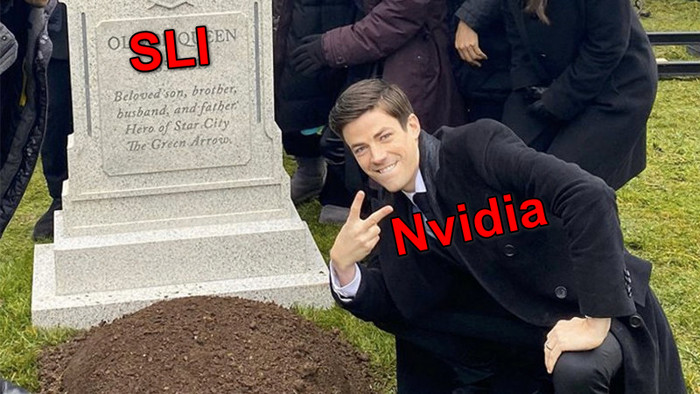
GTX 10 series was the last to support traditional SLI and RTX 30 series was the last consumer-grade product to support NVLink. Although, it is still supported in professional-grade Nvidia products like Quadro GPUs. Hence, NVLink isn’t really dead, yet.
Frequently Asked Questions
Is NVLink dead?
From RTX 4000 series & forward, Nvidia is no longer supporting NVLink on the consumer-grade GPUs. NVLink is now only available for the Quadro lineup.
What GPUs support NVLink?
Currently, the Nvidia Quadro GV100, GP100, Quadro RTX, Titan RTX, RTX 20-series, RTX 30-series, Professional Ampere RTX, & Nvidia’s Data Center GPUs support NVLink.
How many GPUs can SLI support?
Nvidia’s SLI technology can support up to four graphics cards.
Wrapping Up
In conclusion, I wouldn’t bother with either NVLink or SLI since the hassle & cost of such a multi-GPU system outweighs its benefits, especially in gaming. But NVLink has started to make traction among professionals who need a hefty chunk of VRAM.
Now you know all the essential differences between NVLink and SLI. Feel free to ask any query in the comment section below.
Adios!

